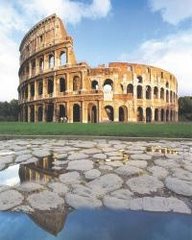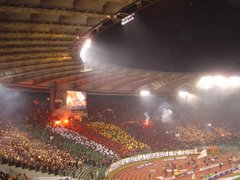The Arches of ancient Rome
An architectural element that was born in Rome, the honorary or triumphal arch was the greatest homage the city could pay to its victors. At the end of a victorious campaign, they had to pass underneath a sacred gate to celebrate their undertakings and, according to a more religious meaning, depose their potential destroyer. Already existing in the 2nd century B.C., the arches multiplied during the Imperial Age when, more than the victory as such, they celebrated the emperors or the members of their family. At the end of the Empire, around 40 arches could be counted in Rome, built at the entrance to the Forums, along the major access roads, or in the monumental areas and squares. Several of these are still preserved in excellent condition today.
The itinerary can star in the zone of the Velabrum, on the eastern edges of the Forum Boarium, where we find the great Arch of Janus, built in the 4th century A.D. in honour of the emperor Constantine or, perhaps Constantius II.
It is the only four-fronted arch, with four barrel-vaults, preserved in Rome. In fact, the name "Janus" (from the Latin Ianus, which means "covered passage with four fronts") derives from this characteristic. The monument, which in the Middle Ages was transformed into a fortress by the Frangipane family, remained intact up until 1830, when the attic and top were torn down because they were erroneously believed not to belong to the original structure. Fragments of the dedicatory inscription are still preserved inside the nearby church of San Giorgio al Velabro.
It is said that in 1601, an abyss suddenly opened up underneath the Arch of Janus, causing the disappearance of a woman, swallowed by the earth as she was walking with her daughter. Obviously, for this reason the Romans, especially in less recent times, did not willingly pass beneath the arch.
Right behind the Arch of Janus, against and partly incorporated into the church of San Giorgio al Velabro, is the Arcus Argentariorum. More than an arch, it was probably a monumental gate of the Forum Boarium opened, as indicated by the inscription, in 204 A.D. by the local money-changers (argentarii) and merchants (negotiantes), in honour of the emperor Septimius Severus and his family.
The monument, almost 7 metres tall, perhaps had statues of the imperial family on its top. Traces of chiselling indicate that several figures, such as those of Geta, Plautianus and Plautilla, the wife of the emperor Caracalla, were purposely eliminated because they represented persons whom Caracalla himself had had killed. Following the invention of the popular motto "Tra la vacca e il toro, troverai un gran tesoro" (Between the cow and the bull, you'll find a great treasure), which spread concerning the riches the arch allegedly concealed, several holes were opened in it in the past centuries, and can still be seen today.
Walking towards the Capitol, we can enter the Roman forum where, near the Curia, it is possible to admire the Arch of Septimius Severus.
The arch was erected in 203 A.D. to celebrate the tenth anniversary of the reign of emperor Septimius Severus, who had returned in victory from the wars in Partia (today Iran and Iraq), fought together with his sons Caracalla and Geta.
Observing carefully the inscription on the attic, it can be seen how at the height of the fourth line from the top the holes corresponding to the nails which held the bronze letters, now missing, do not coincide with the course of the current letters. This means that already in ancient times the text had been reworked: in fact, the fourth line initially contained the name of Geta, the second son of Septimius Severus, whom Caracalla had killed after their father's death in order to seize total power. On this occasion, the very memory of Geta was condemned, and his name and images were removed from all the public monuments in the Empire.
The arch, one of the largest in existence, is in a good state of preservation because it was incorporated into a fortress during the Middle Ages, against a tower belonging to the Brachis family, who gave their name to the locality called "Le Brache".
Also in the Roman Forum, along the Via Sacra, going towards the Colosseum, stands the Arch of Titus.
One of the most famous arches in Rome, it was erected between 82 and 90 A.D. in honour of the deified Titus. It was raised by Domitian, the emperor's brother, to commemorate the victory against the Jews and the capture of Jerusalem by Vespasian and Titus himself.
According to tradition, the Jews have never passed underneath the arch, in order to avoid paying homage to he who had destroyed the temple of Jerusalem.
On the side facing the Colosseum, the dedicatory inscription, originally bearing bronze letters, is still preserved. The metal was stolen, and therefore today there remain only the holes of the cramps used to hold the letters saying "Senatus Popolusque Romanus divo Tito divi Vespasiani F(ilio) Vespasiano Augusto" (The Senate and the Roman people to the divine Titus Vespasian Augustus son of the divine Vespasian).
The abbreviation S.P.Q.R. comes from the expression Senatus Popolusque Romanus, with which resolutions were begun in ancient Rome. Today it is still one of the symbols of Rome, together with the She-wolf. The Roman poet Belli interpreted the abbreviation, explaining it in a sonnet, as meaning "Solo Preti Qui Regneno" (only priests reign here), referring to the temporal power of the Church of Rome, maintained until 1870.
One of the bas-reliefs on the inside of the arch represents the procession preceding the emperor as he passes beneath the Triumphal Gate, carrying the booty taken from the temple of Jerusalem: the silver trumpets, the golden table, the ark that contained the sacred scriptures, and the seven-branched candelabrum, the depiction of which is probably the most ancient that has arrived up to the present day. For this reason, in the Middle Ages it was nicknamed "Arch of the Seven Lamps" and incorporated into the fortress of the Frangipane family. It was freed in the 19th century during the restoration work directed by Giuseppe Valadier.
Stendhal, on a trip to Rome in the early 1800s, speaking of the arch, said, "It, after that of Drusus near Porta San Sebastiano, is the most ancient arch in Rome, and was also the most beautiful until when it was restored by Mr. Valadier. This wretch who, notwithstanding his French name, is Roman by birth, instead of reinforcing the arch… thought it well to rebuild it from scratch".
There is a fascinating hypothesis that alleges that the arch was used to keep, temporarily, the ashes of the emperor Titus before they were laid in the family tomb erected on the Quirinal Hill in 94 A.D.
Lastly, in piazza del Colosseo we can see the majestic Arch of Constantine, erected in honour of Constantine, in the tenth year of his reign (315 A.D.), to celebrate the victory over Maxentius in the battle of Ponte Milvio (312 A.D.).
Almost 25 metres tall, it is the largest triumphal arch preserved in Rome. It is an exceptional example of the practice, followed systematically in Rome since antiquity, of stripping ancient monuments for materials to build new ones; indeed, here we can find, alongside original Constantinian elements, reused sculptures and architectural elements coming from monuments of Trajan, Hadrian and Marcus Aurelius. It is interesting to remember that the arch was completed with precious pictorial and metal decorations. The dominating colours were gold and purple, the colours of the Empire.
Recent studies have also raised doubts about the fact that the arch reused pre-existing masonry structures, perhaps of the 2nd century A.D.
Transformed into a fortification tower by the monks of St. Gregory in the Middle Ages and later incorporated into the Frangipane fortress, the arch was restored several times and finally brought totally to light in 1804.












